
Station Name: YARMOUTH SOUTH TOWN[Source:
Darren Kitson]
Yarmouth South Town Gallery 5: 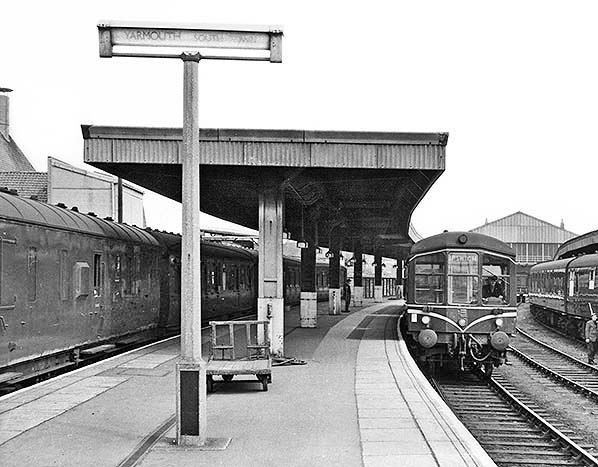
A busy scene at South Town viewed from Platform 3 on Thursday 3 May 1962. On the left, at Platform 4, stands an ex-LMS BG (a full brake) behind which is an ex-LNER Thompson suburban lavatory composite, while further along are two unidentified non-gangwayed coaches which look suspiciously like a Push & Pull set although these should have disappeared by this time. The ex-LMS Stanier Period III BGs, some of which were built in BR days, enjoyed long and useful lives, remaining a familiar sight well into the BR blue era. The Thompson suburbans, despite the name, were also used on branch and local services. At Platform 3 a Derby Lightweight DMU is departing for Ipswich. The unit displays what were commonly known as 'Speed Whiskers' but which were in fact an early type of visual warning device. This was a sensible precaution as track workers and other staff were accustomed to the more audible approach of steam locomotives. Given that the Derby Lightweights were restricted to a maximum speed of 65mph the term 'Speed Whiskers' was mildly comical. The device was replaced by the yellow warning panel. Compatible with the 79xxx Metro-Cammell units, the Derby Lightweights also originally had their jumper cables stowed in a cupboard in the driving cabs. In this view the cable sockets can be seen below the outer windscreens. Although the driving method was the same as the Metro-Cammells, the layout of the Derby Lightweight driving cabs differed and was rather cruder. The elaborate 'glasshouse' windscreens were problematic and drivers complained of them being a source of reflections. The Metro-Cammell units, with their smaller, raked back windscreens caused no such complaints. Just visible in this view is the unusual windscreen wiper fitted to most of these units, with a central pivot and blades wiping top and bottom sections of the driver's windscreen. It is said this arrangement was used to aid signal sighting and in particular when watching the Starter signal when at a station platform. At Platform 2, right, a main line set is seen with the vehicle nearest the camera and largely out of the picture being an RB (Restaurant Buffet). From November 1959 all trains operated via Lowestoft and from the end of June 1962 regular main line services were withdrawn from South Town altogether. Many of the DMU services to and from Ipswich at this time ran semi-fast, omitting Corton, Hopton, Lowestoft North and some stations between Beccles and Ipswich. The reversal at Lowestoft Central occupied just three minutes. Trains for Liverpool Street also ran semi-fast. Reversal at Lowestoft Central, which involved uncoupling the incoming locomotive and attaching another, which had been waiting, to the other end was generally allowed five minutes. Certain trains from South Town to Liverpool Street joined at Ipswich with a portion from Norwich or vice versa. There were complaints from passengers, not so much about increased journey time via Lowestoft but more because the additional mileage increased the fares. By 1962, however, more London trains were running to and from Yarmouth Vauxhall and ultimately Vauxhall won the battle. One had to study timetables carefully, though, as the Vauxhall trains were also shown in the South Town timetable and differentiated by a key letter at the top of the column. Towering above the camera is one of South Town's fluorescent platform lamps complete with the fading lettering which became a hallmark of the station in later years. Beneath the canopy some of the station's charming LNER style suspended lamps are visible. At the far end of Platform 4, which ends short of the station building, the suspended Eastern Region 'Platform 4' sign can just be seen.
Photo by British Railways Photographic Unit and courtesy of Bob Randall
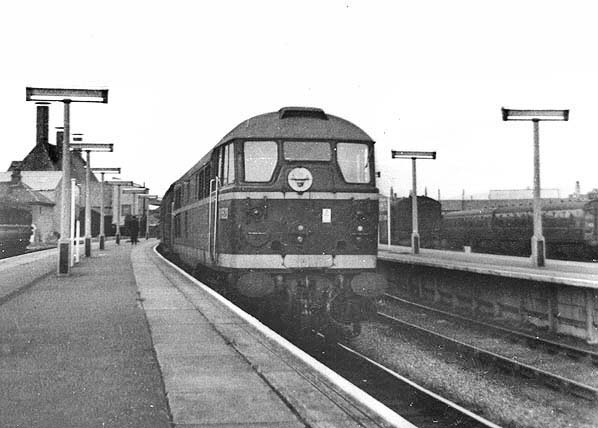
One of the earlier Brush Type 2s with disc instead of alpha-numeric headcode awaits departure from South Town with, the headcode disc tells us, a stopping train for Ipswich. The locomotive appears to be, under magnification, D5529. Assuming this to be the case D5529, which was new in May 1959, was shedded at Ipswich from September 1961 until May 1968, when she was rebuilt from Class 30 to 31, so this view likely dates from the late 1961 to June 1962 period. At the time she was photographed D5529 had her original Mirrlees engine and these sounded vastly different to the English Electric engines which replaced them, the Mirrlees emitting a mildly comical gurgling sound. There was nothing wrong with the Mirrlees engines but when BR decided that greater power output was required the Mirrlees JVS12T was found unsuitable for uprating. D5529 ultimately became No.31111 and was to survive in service until June 1983, by that time moved away from her native East Anglia and allocated to York. Much has been said about South Town's arrival and departure platforms, this being how the station was originally designed as were numerous other termini. The system, however, ‘went out of the window’ at busy times and especially during the summer after 1903 and the train seen here is awaiting departure from what was ostensibly the arrivals platform, Platform 2. It will be noticed that at the outer ends of the platforms there were only two tracks; platform spacing widened closer to the station building to accommodate the centre release road and the two-track situation at the outer end was the result of the 1884 platform lengthening. The points for the release road were roughly where the carriage behind the locomotive is sitting. To the right of the locomotive, parcels vans are stabled in Platform 1. This and stabling of passenger stock was seemingly the main purpose of this platform. At far right, passenger stock is stabled apparently on one of the roads leading to the goods yard and this appears to have been a frequent occurrence at busy times. Also visible, just, are South Town's BR Eastern Region running-in boards mounted on white painted stanchions. One of these is believed to have survived. At far left another carriage sits on the siding while the maltings towers over the scene in the background.
Photo by Roderick G Kerry 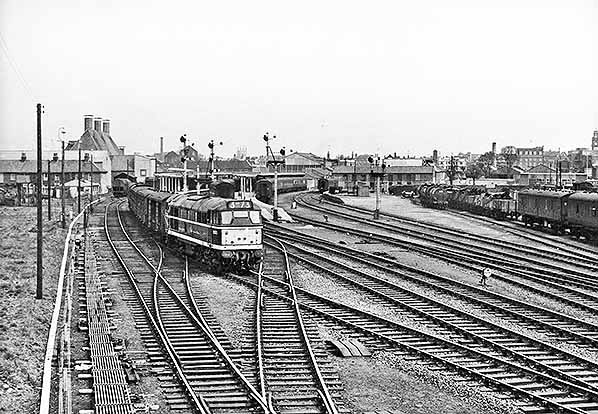
South Town station viewed from the signal box on Thursday 3 May 1962. Brush Type 2 No.D5575 is departing from Platform 4 with a parcels and/or perishables train for Lowestoft and Ipswich. As always at South Town, rolling stock is scattered around on a 'find somewhere to put it' basis. At the platforms are examples of Gresley, Thompson and BR Mk1 stock while at the cattle dock, of all places, sits a lone BR Mk1 which is either a BSO or BSK. At far right and sharing a siding with some open wagons, some of which have tarpaulins, is a BR GUV van and an LMS designed BG. These vehicles are hiding the coal wharf which was on the extreme right and beyond which were further sidings, upon which more wagons, open and box van types, can just be made out. Messrs Pickfords premises is in the right background while beyond it, but on the other side of the river, stands the clock tower of Great Yarmouth Town Hall. The siding to the left of the parcels train has a short stub siding branching from it, just beyond which was a loading dock for the maltings. On the stub siding stand two Bulk Grain wagons; once a common sight in East Anglia, the type became generally well known due to being modelled by Hornby-Dublo. The track between Platform 1 and the cattle dock is that which bullied its way across Southtown Road to the goods yard. It split into two tracks just behind the Mk1 coach. No. D5575 was new to traffic in December 1959, allocated to Norwich Thorpe. After a brief spell at March she returned to Norwich and was allocated there when photographed at South Town. After many years jostling between various East Anglian and London sheds, during which time she morphed into No.31157 and then into No.31424, she ended up at Crewe from where she was withdrawn in May 1996. She was to linger for a further ten years, however, before being scrapped at Rotherham, not at the well known Booth's yard but at the lesser known and relatively recently established Parkgate yard of Ron Hull.
Click here for a larger version. Photo by British Railways Chief Civil Engineer, King's Cross, and courtesy of Bob Randall 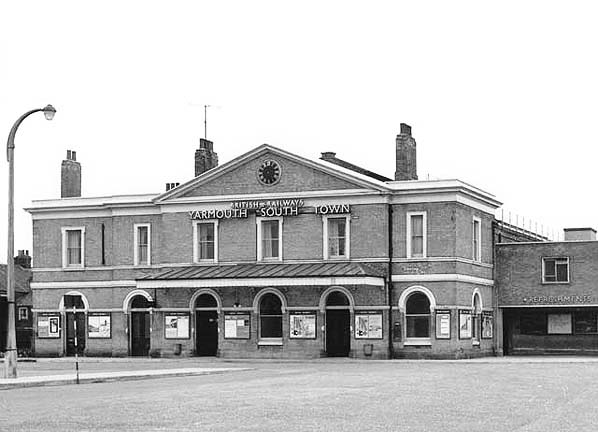 South Town station building and forecourt sometime in the 1960s. On one of the chimneystacks is mounted what might be a UHF television aerial (it is too unclear to be certain), in which case the photograph will be later than 1964 but before 1966 when the station became a boarded-up unstaffed halt. As with the similar view from 1977 the asymmetry of the station building is clear to see, this being the result of the extra stationmaster's accommodation added by the GER. This view, being clear of obstructions both vehicular and anthropological, is ideal for describing what lay behind the various doors and windows following the 1952 alterations. From the left, the first doorway led into the stationmaster's lobby and from which led a stairway to his accommodation on the first floor. Annexed to the lobby was a small coal store, presumably for the stationmaster's use, and which occupied the extreme left corner of the building. The fact the stairway was in the extension added by the GER tells us the original stairway was located elsewhere but precisely where is not known. The second doorway, not for public use, led into the enquiry office, behind which was the relocated ticket office. This doorway was originally a window, thus giving symmetry to the original frontage. The third doorway was the public entrance to the booking hall; on entering and immediately on the left was the enquiry office desk for use by the public. Next to the enquiry office and still on the left was the 1952 ticket office with an 11ft 6in counter frontage. The window to the right of the third doorway looked into the booking hall and was directly in front of the pre 1952 ticket office (see pictures of this office). The doorway to the right of the window was ostensibly the exit from the booking hall. Directly opposite these third and fourth doorways were doorways leading from the booking hall to the concourse. Behind the window facing the camera at the right-hand end of the building was the stationmaster's office, behind which was the stationmaster's clerk's office. The window in the north end of the building looked into said clerk's office. This office contained a wash basin but no toilet facilities for the clerk or his boss, nor was it possible for the stationmaster to reach his office directly from his domestic accommodation - the only access being via the concourse. At far right is, of course, the 1952 waiting and refreshments room. This building extended back along the entire north side of the concourse. Beneath the front, below the 'Refreshments' sign, was a ramp leading up to a doorway which led onto the concourse and it was thus not possible to reach the waiting and refreshments room without first entering the concourse. In the centre of the forecourt the former garden has gone and a kerb and lamp standard have appeared. The sign in front of the lamp might suggest that the area had become a taxi rank or what is now commonly known as a drop-off point. The taxi rank, at least originally, had been to the right and was provided with a cabmen’s shelter. The one-time rather grand departures board had stood behind and to the left of the camera. The flow around the forecourt was very orderly; the boundary with the street pavement was marked by a low wall in which were two openings, a ‘Way In’ (to the left of this photograph) and a ‘Way Out’ (where the photographer was standing). Thus people and vehicles entering and leaving the station did so in a clockwise direction as had previously been the case. Whilst this arrangement might suggest the station was somewhat pretentious, it would have been essential in the heyday of holiday traffic when large numbers of people would be coming and going at any one time.
Photo from Terry Wilson 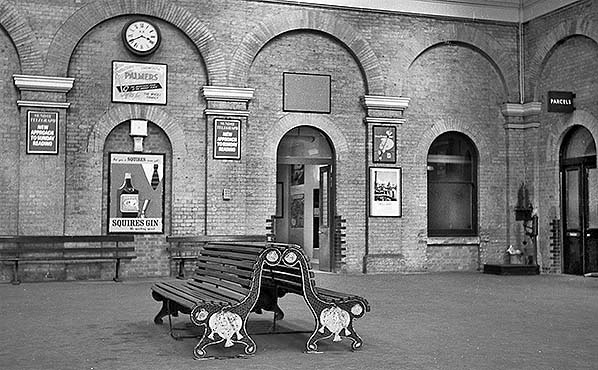 Two of the 'fish themed' benches on the concourse of South Town station, photographed in April 1963. This view is worth comparing with those showing one of the benches at the National Railway Museum (NRM). One would assume that the bench at the NRM is displayed in something like its original condition, nameplate excepted. How many of these benches originally existed is not known. Not readily apparent in this view are certain of the alterations made to the station in 1952. The new ticket office was through the open doorway and on the right. The doorway at far right, despite the Parcels sign above it, led into what BR called a Luggage Lobby. To the right of the door, out of view, was a hatch with wooden roller shutter for parcels. The original ticket office was located directly behind the arch with the Squires Gin advertisement. On this side of the arch a tobacco kiosk once stood, removed sometime after 1952 and probably in 1962. What we are facing here is the inner wall of the station building, the W H Smith bookstall and platforms being behind the camera. The clock is marked 'B.R.' and would have been a synchronous clock. In the arch, the switch and fuse boxes may have been connected with the clock although they appear to be rather an ‘overkill’ given that synchronous clocks draw very little current. Not all of the advertisements are readable. Apart from Squires Gin and the Sunday Telegraph offering a 'New Approach To Sunday Reading' the only other discernible one is that for Palmers, beneath the clock. At the top it welcomes people to Yarmouth and at the bottom it says 'For The Whole Family'. Palmers is a department store overlooking Great Yarmouth's market place and is still in business as of 2017. As this and other pictures show, the interior of South Town station was a somewhat forbidding place. No doubt regular passengers got used to it while excited, arriving, holidaymakers had other things on their minds but it must have been quite depressing while waiting for a train at the end of a holiday. The 1952 alterations did little to take the station out of the nineteenth century and seem to have been done more for practical reasons than to make the station rather more welcoming, although the removal of the trainshed would have helped to relieve the gloom (and increase the cold draughts).
Photo by David Pearson 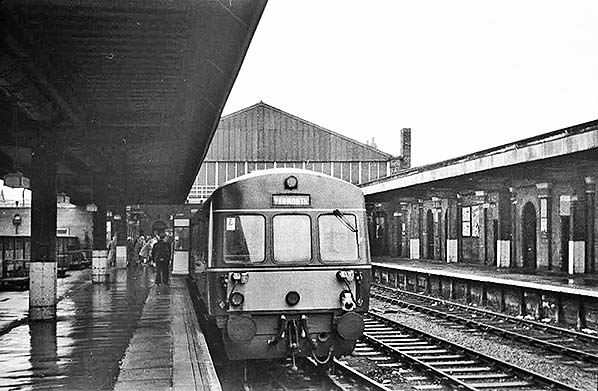
On an apparently damp and dismal 12 December 1964 a Metro-Cammell 79xxx series DMU has just arrived at South Town's Platform 3. No doubt the DMUs Smith-Webasto heaters were operating at full blast - they usually were. Regular through trains via Lowestoft had ceased in 1962 and a few months before this photograph was taken summer excursion traffic had also ceased, being diverted to Vauxhall and thus avoiding reversal at Lowestoft. Platform 2, right, still with its noticeboards and rather nice suspended lights was by now, for all intents and purposes, disused. Compare this view to the similar one taken in 1968. Virtually invisible in this view, but visible on an enlarged and lightened version, are suspended BR Eastern Regions signs indicating Platform 3 and Platform 4. In the left background the waiting and refreshment room can be seen, probably closed by this time after a mere ten or so years ‘use. This view is convenient to outline the differences between the 79xxx Metro-Cammells and what became Class 101. On the 79xxx type, externally there was a fairing beneath the bufferbeam and through which the warning horns protruded. Multiple unit jumper connections were below the outermost windscreens; originally the jumper cables were kept in a cupboard in the driving cab (at both ends) when not required but later dummy cable docks were fitted and thereafter jumper cables remained on the outside and the same applied to the Derby Lightweight units. The driving method for the 79xxx series was the same as with the Blue Square diesel-mechanical units but the controls differed in layout and appearance; the power controller, for example, was a steel rod with Bakelite knob and mounted at the bottom the panel to the driver's left, below the engine start/stop controls, rather than being desk mounted. The gear change lever was more akin to those of the GWR diesel railcars, as indeed it was on the Derby and Swindon 79xxx units. These minor details aside, the major difference was the 'Yellow Diamond' circuitry which was compatible only with other so-coded units. A further difference with the Metro-Cammell and Derby Lightweight units, compared to the Blue Square units, was that they were for some reason restricted to 65mph and a sign in the cabs so-advised drivers. Oddly, the Wickham Class 109 units were also restricted to 65mph and this little detail has been overlooked by preservationists. Nevertheless, these units were well capable of exceeding 65mph and often did. When what we now call 'First Generation' DMUs first appeared they were criticised in some quarters for using obsolete technology. True as this was, the critics chose to ignore the fact that it was proven technology. Because of this the Metro-Cammells, to single out one type, ‘worked straight from the box’ and performed virtually faultlessly throughout their careers.
Photo by Bevan Price 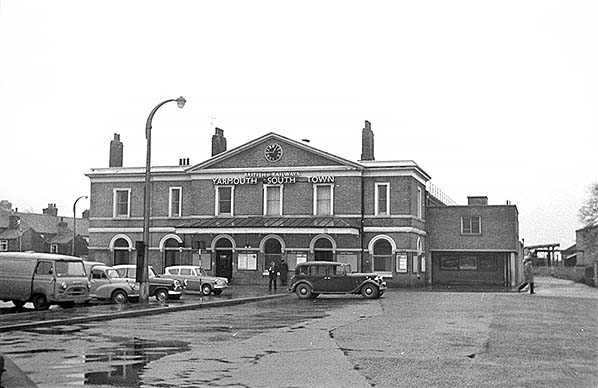
South Town station forecourt on an obviously dismal 12 December 1964. Regular main line train services had ended two years previously and 1964 had seen the end of summer excursion traffic which of course had by then operated via Lowestoft. Unsurprisingly, the refreshment room, right, had closed but it is unclear from this view if its signage remained or been removed but with its imprint remaining on the brickwork. Where the station garden had once been, road vehicles now park and the scene belies the fact that the only passenger train service remaining was that from Lowestoft. The station was still staffed, however, and would be so for a further three years until goods services were withdrawn. The Lowestoft service became conductor-guard operated in 1966 so the only staff at South Town in the 1966 - 67 period would have been to oversee goods traffic. The period road vehicles are from the left, an Austin J4 van, a Morris 1000 van, a Ford Consul Mark II and a Ford Anglia 105E - and the DeLuxe version at that. The large and older car, standing aloof, is difficult to positively identify but looks suspiciously like an Austin 16/6 Chalfont. The Austin J4 came with various types of bodywork and also with Morris, BMC and possibly Leyland badging. Once a common sight with, for example, Royal Mail and certain police forces, the J4 was eventually replaced by the Sherpa in 1974. The Ford Consul Mk II is also worth an additional mention in that it was the first British car to feature a combined key-operated ignition and starter control. Previously British cars had a separate key-operated ignition switch, usually mounted on the dash, and a separate starter (if fitted with a starter motor), either a pull-out knob or pushbutton on the dash or a floor-mounted switch. The older car, suspected of being an Austin, has rear 'suicide doors'. Hinged at the rear, they had a tendency to burst open at speed and mishaps were not uncommon. The mildly comical term 'suicide doors' seems to have originated in the USA.
Photo by Bevan Price 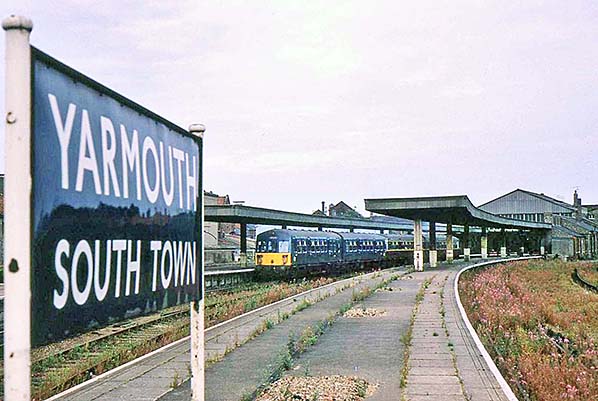
With no mistaking the location, a 4-car Metro-Cammell 79xxx series DMU waits at Platform 3 with a service to Lowestoft. The photograph is undated but will be sometime between 1965 and 1968. On the right, the tracks into Platform 1 and through to the goods yard are all but hidden beneath undergrowth. In his report The Reshaping of British Railways Dr Richard Beeching instigated the phasing-out of wagon-load goods traffic, although this took a further two decades to implement. An early victim was fish traffic which ceased in 1964 and although South Town remained open for general goods traffic until November 1967 what remained after the goods yard closed in January that year was handled in the station area. The leading DMU, jumper cables in place on the cab front, is in a livery which has come to be known as 'Chromatic Blue'. BR blue had appeared in 1964 (with the XP64 train) with general application beginning in 1965. Chromatic Blue has been a source of controversy ever since in that it remains a mystery whether it was a deliberate shade or a chemical reaction due to being applied over rubbed-down BR green. Whatever the answer, Chromatic Blue had a slight metallic appearance with a hint of turquoise. As an aside, the writer once repainted a green Hornby-Dublo Metro-Vick Co-Bo into Rail Blue and the result was the same. At the same time as BR began repainting DMUs into Chromatic Blue, to adhere to that name, many were also given relatively small 'double arrow' logos and annoyingly, for spotters, numbers and this appears to be the case in this view. A well known example in East Anglia was Cravens car E56443 which ran around for some considerable time in this livery but with a smaller yellow warning panel to that seen here. The second unit seen here is still in green livery. The white panel just visible at its far end was of some form of rubbery material applied retrospectively. Its purpose was to prevent damage to bodywork during token exchanges. This involved tokens being placed in a pouch attached to a large hoop and which, when exchanged on the move, tending to swing back and clout the bodywork. Without knowing the precise date of this photograph we do not know if conductor-guard working had been introduced, this occurring in 1966. Where it had been and two DMUs were coupled together, as here, there would normally be two guards on the train but this expensive practice would occur only at busy times, this this photograph may have been taken on a Saturday. See next image.
Photo by Phil Dyson from his Flickr photostream 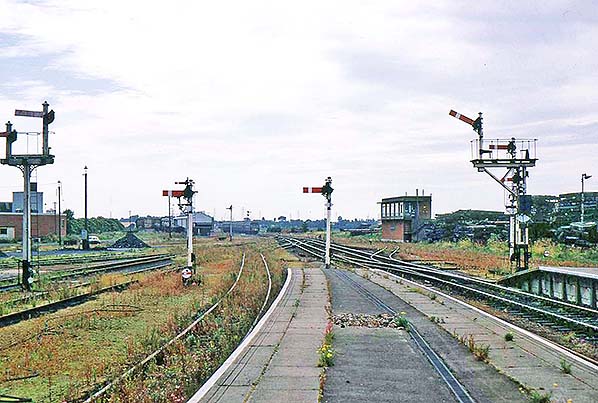 The DMU seen in the previous view has rasped away from Platform 3 and can be seen in the distance passing the locomotive shed. It will shortly diverge from the by-then-closed Beccles route and swing away south-eastwards towards Gorleston. It arrived on the Down main line and having departed, it has crossed over to the Up main line as dictated by the signalling and track layout at what had been Yarmouth South Town Junction. Following on from the previous caption we therefore know that this and the previous view predate 1966, the year the Lowestoft line became single track. Most signals now have upper quadrant arms and steel posts but that at far left has not been so modernised. It had controlled the northernmost of the two tracks from the goods yard, the other being controlled by the signal partly obscured by that second from left. The purpose of the white diamonds, seen here on the posts and on the ground signal, is described elsewhere. South Town was still open for goods traffic but there is little evidence of it and by this time coal and timber would be the predominant commodities. The locomotive turntable was in the left centre background, beyond the heap of coal, but is difficult to see due to the encroachment of weeds. The water tower has already been demolished. The car on the left, partly hidden by a lamp post, has received a livery suspiciously resembling of BR 'blood and custard'. Impossible to identify with any certainty it does, however, appear to be a 2-door Austin A30 or A35. The writer once owned an Austin A40 Somerset in the same livery but was not responsible for its application.
Photo by Phil Dyson from his Flickr photostream 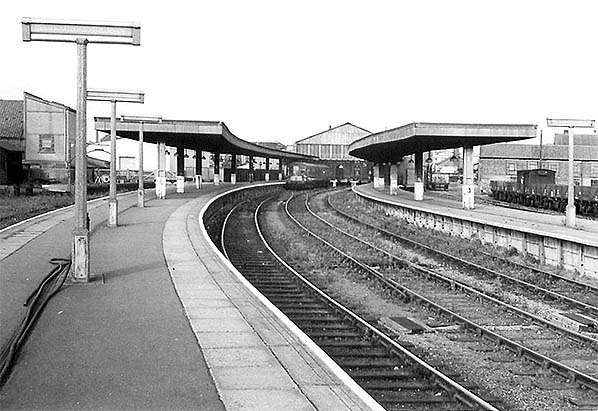
South Town in September 1966, at the time when the Lowestoft service was switched to conductor-guard operation and all through traffic, such as it was by this date, via Lowestoft ceased. Through summer holiday traffic ceased in 1964, thereafter and until 1966 just the occasional excursion operated. A Derby Lightweight DMU waits at Platform 3 prior to bouncing its way to Lowestoft. Through the gap towards the right can be seen one of the buildings in the goods yard, with the Yare Hotel partly visible beyond it and on the other side of the river. The hose lying on the platform would have been for filling carriage water tanks but it is unlikely that it was ever used for this purpose again.
Photo
from John Mann collection
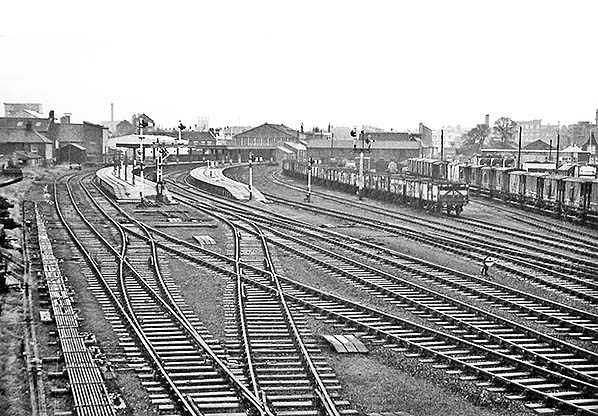 Yarmouth South Town viewed from the signal box in April 1967, by which time the station saw only local service from Lowestoft and goods traffic. Of the signals, the bracket on the left carries the starter signals for Platforms 4 and 3, the single signal to its right is the Platform 2 starter and to the right of that is the Platform 1 Starter. The wooden signal, still with lower quadrant arms, controls one road from the goods yard to the main line while the smaller arm is a shunt signal. The road upon which the coal wagons are standing was the second road from the goods yard and the signals for this are out of view to the right. Part of the coal yard can be seen in the right background and coal traffic appears to have also taken over the former cattle dock. The rake of box and brake vans was possibly in storage and awaiting scrapping. Two, at least, of the brake vans are of Great Eastern origin. Goods traffic was withdrawn from South Town later the same year and, Platform 4 road excepted, all tracks seen here were lifted during the spring of 1968. Yarmouth South Town viewed from the signal box in April 1967, by which time the station saw only local service from Lowestoft and goods traffic. Of the signals, the bracket on the left carries the starter signals for Platforms 4 and 3, the single signal to its right is the Platform 2 starter and to the right of that is the Platform 1 Starter. The wooden signal, still with lower quadrant arms, controls one road from the goods yard to the main line while the smaller arm is a shunt signal. The road upon which the coal wagons are standing was the second road from the goods yard and the signals for this are out of view to the right. Part of the coal yard can be seen in the right background and coal traffic appears to have also taken over the former cattle dock. The rake of box and brake vans was possibly in storage and awaiting scrapping. Two, at least, of the brake vans are of Great Eastern origin. Goods traffic was withdrawn from South Town later the same year and, Platform 4 road excepted, all tracks seen here were lifted during the spring of 1968.Photo from John Mann collection
 Home Page Home Page
|
